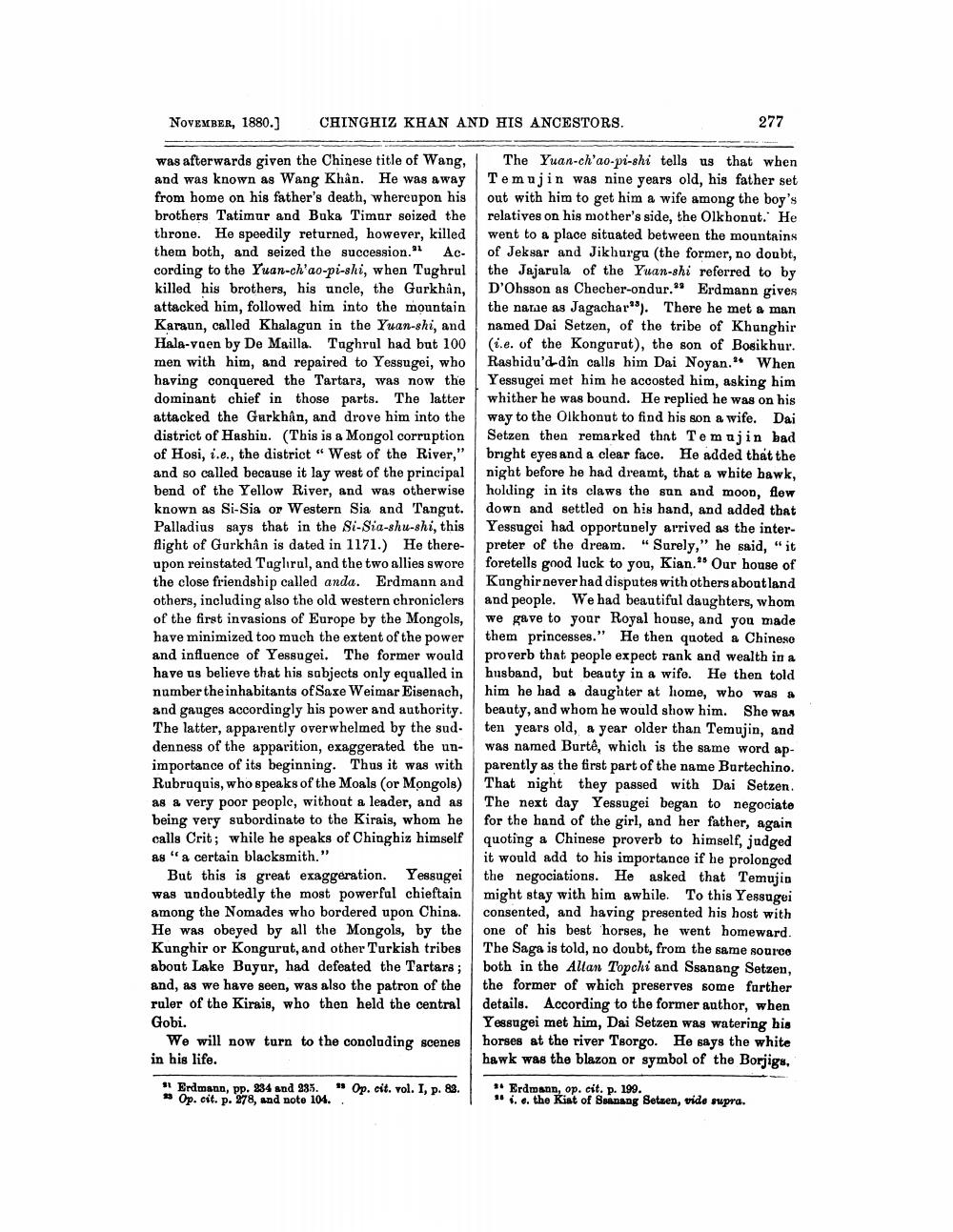________________
NOVEMBER, 1880.)
CHINGHIZ KHAN AND HIS ANCESTORS.
277
was afterwards given the Chinese title of Wang, and was known as Wang Khân. He was away from home on his father's death, whereapon his brothers Tatimur and Buka Timur seized the throne. He speedily returned, however, killed them both, and seized the succession." ACcording to the Yuan-ch'ao-pi-shi, when Tughrul killed his brothers, his uncle, the Gurkhan, attacked him, followed him into the mountain Karaun, called Khalagun in the Yuan-shi, and Hala-vaen by De Mailla. Taghrul had but 100 men with him, and repaired to Yessugei, who having conquered the Tartara, was now the dominant chief in those parts. The latter attacked the Gurkhan, and drove him into the district of Hashin. (This is a Mongol corruption of Hosi, i.e., the district "West of the River," and so called because it lay west of the principal bend of the Yellow River, and was otherwise known as Si-Sia or Western Sia and Tangut. Palladius says that in the Si-Sia-shu-shi, this flight of Gurkhân is dated in 1171.) He thereupon reinstated Taglıral, and the two allies swore the close friendship called anda. Erdmann and others, including also the old western chroniclers of the first invasions of Europe by the Mongols, have minimized too much the extent of the power and influence of Yessugei. The former would have us believe that his sabjects only equalled in number the inhabitants of Saxe Weimar Eisenach, and gauges accordingly his power and authority. The latter, apparently overwhelmed by the sud. denness of the apparition, exaggerated the unimportance of its beginning. Thus it was with Rubruquis, who speaks of the Moals (or Mongols) as a very poor people, without a leader, and as being very subordinate to the Kirais, whom he calls Crit; while he speaks of Chinghiz himself as" a certain blacksmith."
But this is great exaggeration. Yessugei was undoubtedly the most powerful chieftain among the Nomades who bordered upon China. He was obeyed by all the Mongols, by the Kunghir or Kongurut, and other Turkish tribes about Lake Bayar, had defeated the Tartars ; and, as we have seen, was also the patron of the ruler of the Kirais, who then held the central Gobi.
We will now turn to the concluding scenes in his life.
The Yuan-ch'ao-pi-shi tells us that when Temujin was nine years old, his father set out with him to get him a wife among the boy's relatives on his mother's side, the Olk honut. He went to a place situated between the mountains of Jeksar and Jikhurgu (the former, no doubt, the Jajarula of the Yuan-shi referred to by D'Ohsson as Checher-ondur." Erdmann gives the name as Jagacharos). There he met a man named Dai Setzen, of the tribe of Khunghir
i.e. of the Kongurat), the son of Bosikhur. Rashidu'd-din calls him Dai Noyan. When Yessugei met him he accosted him, asking him whither he was bound. He replied he was on his way to the Olkhonut to find his son a wife. Dai Setzen then remarked that Temujin bad bright eyes and a clear face. He added that the night before he had dreamt, that a white bawk, holding in its claws the sun and moon, flew down and settled on his hand, and added that Yessugoi had opportunely arrived as the interpreter of the dream. "Surely," he said, "it foretells good luck to you, Kian. Our house of Kunghir never had disputes with others about land and people. We had beautiful daughters, whom we gave to your Royal house, and you made them princesses." He then quoted a Chineso proverb that people expect rank and wealth in a husband, but beauty in a wife. He then told him he had a daughter at home, who was a beauty, and whom he would show him. She was ten years old, a year older than Temujin, and was named Burtê, which is the same word apparently as the first part of the name Burtechino. That night they passed with Dai Setzen. The next day Yessugei began to negociate for the hand of the girl, and her father, again quoting a Chinese proverb to himself, judged it would add to his importance if he prolonged the negociations. He asked that Temujin might stay with him awhile. To this Yessugei consented, and having presented his host with one of his best horses, he went homeward. The Saga is told, no doubt, from the same source both in the Allan Topchi and Ssanang Setzen, the former of which preserves some further details. According to the former author, when Yessugei met him, Dai Setzen was watering his horses at the river Tsorgo. He says the white hawk was the blazon or symbol of the Borjigu.
Erdmann, pp. 234 and 335. * Op. cit. vol. I, p. 83. 13 Op. cit. p. 278, and note 104...
** Erdmann, op. cit. p. 199. 11. e. the Kiat of Ssanang Setzen, vide supra.




